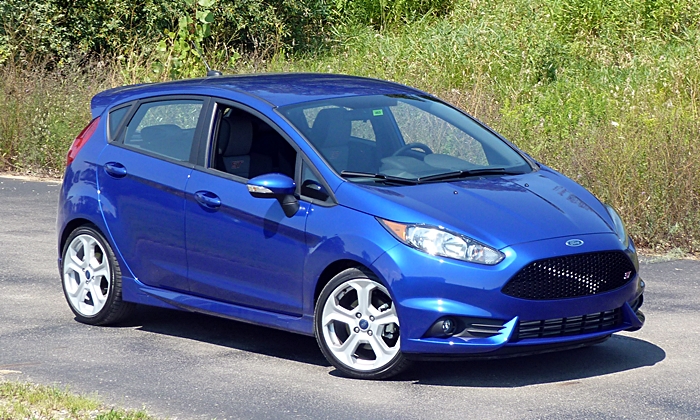Since driving the Ford Focus ST last year, it's been the car I would most likely buy for myself. But, with agile handling leading my priorities, smaller and lighter tend to be better. For 2014 the Fiesta, a foot shorter (160 vs. 172 inches), four inches narrower (68 vs. 72), and a quarter-ton lighter (2,742 vs. 3,223 lbs.) than the Focus, has received Ford's high-performance ST treatment. Does it unseat its big brother in the battle for my affections? For anyone similarly in search of a four-door pocket rocket, is the Fiesta ST now the one to get?
Clearly, Ford hopes that the Fiesta ST will steal sales from some cars other than the Focus ST. But the car has no direct competitors in North America, at least not yet. Chevrolet offers the similarly-sized Sonic in a sporty RS form, but neglected to upgrade the engine. The Sonic's 138-horsepower turbocharged 1.4-liter isn't remotely in the same league as the Fiesta ST's 197-horsepower turbocharged 1.6-liter. The 201-horsepower Hyundai Veloster Turbo is close in power and weight, but is significantly larger and needs another round of steering and suspension tweaks to have a chance against the Fiesta ST. The 160-horsepower FIAT 500 Abarth and 181-horsepower MINI Cooper S are much smaller cars with only two doors and barely-there back seats. MINI does offer a four-door vehicle, but with a height of 61.5 inches Countryman has crossed over. Also, a comparably-equipped MINI is far more expensive than the Fiesta ST. Which brings us to the closest thing to a Countryman--the Nissan JUKE, recently available in 197-horsepower NISMO (Nissan Motorsports) trim. When comparably equipped (sport bucket seats, floormats), the Fiesta ST and JUKE NISMO have nearly identical sticker prices. We have our match.
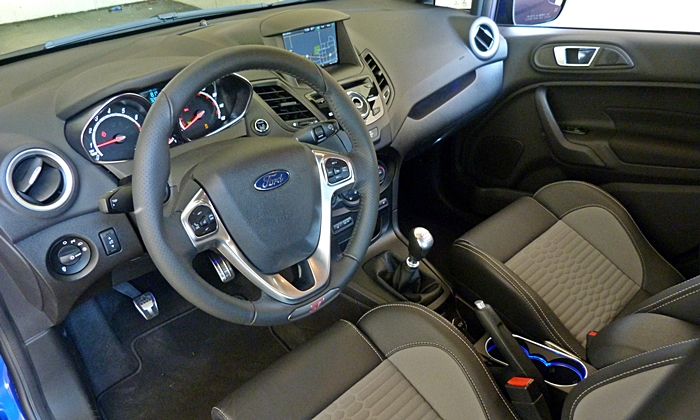
Quality materials, but I wish blue seat inserts like those in the Focus ST were offered.
| |
Compared to the JUKE |
| Handling |
 Better
Worse
Better
Worse
|
Ford's performance car folks knows how to tune a chassis. They did a fantastic job with the Focus ST, and they've done one again with the Fiesta ST, despite the latter's much less sophisticated rear suspension (a twist beam rather than an independent multi-link setup). The small hatch feels as solid, stable, and composed when hustling along a twisty road as the best European four-doors.
Its steering is firm, quick, and accurate. Body roll? Hardly any to speak of. A torque vectoring system works the brakes to counteract understeer, so there's none of the typical nose-heavy front-wheel-drive car's tendency to plow toward the outside curb when the going gets tough. Lift off the throttle heading into a turn, and a touch of oversteer helps the rear end around. Mid-turn, the Fiesta ST's tweaked suspension works with summer tires (you'll need different tires for snow) to place the car's limits well beyond legal speeds on public roads. A sophisticated traction control system effectively transfers the engine's power to the road when accelerating out of the turn.
Sounds great, doesn't it? But you might have noticed that "fun" and "exciting" didn't appear in the preceding description. There's fun to be had in the Fiesta ST, to be sure, but less than I had hoped for. The car is just too damned competent. With the limits so high, there's nothing going on at the tire's contact patches to be felt other than a solid grip on the road. Beyond this, Ford has done such an excellent job refining the Fiesta ST that the driver receives little in the way of sensory input. A distant, steeply raked windshield doesn't help, as it makes the car seem larger than it actually is (a plus for most potential Fiesta buyers, but not for someone seeking an intimate connection with the car).
With quicker, tighter steering and a suspension that reacts more dramatically to driver inputs, the Focus ST actually feels more agile and engaging than its smaller, lighter sib.
Even with meaningful NISMO suspension tweaks, the JUKE doesn't have nearly the composure, balance, or grip of the Fiesta ST. Or traction. Try to accelerate out of a turn, and you'll just make the inside front tire spin. But what the JUKE does have is a puppyish energy and willingness to dart about missing in the more mature Fiesta. On public roads at semi-legal speeds it's easier to have fun in the technically inferior Nissan. (A MINI splits the difference in both technical excellence and driver involvement.)
Ultimately, the problem is less that the Fiesta ST isn't good enough than that few metropolitan areas have nearby roads good enough for the Fiesta ST. If you have a road--or a track--where the Fiesta's potential can be exploited, then it would no doubt be more fun and involving. But do you have one?
| Powertrain performance |
 Better
Worse
Better
Worse
|
There's less power and torque on tap in the Fiesta ST than in the Focus ST, 197 vs. 252 horsepower and 202 vs. 270 lb-ft of torque. The Fiesta ST's steering wheel tugs this way and that under hard accleration, but the tugs are weaker than in the Focus ST. You're also less likely to chirp the tires when shifting, and Focus ST-style wheel hop isn't happening. Even so, the Focus only gets to 60 mph about a half-second sooner (mid-6s vs 7 flat). Yet the difference feels larger than it is, with more discernable shove in the Focus.
The explanation is much the same as for the Fiesta ST's handling. The 1.6-liter engine puts out power so linearly and with so little drama (aside from the semi-synthetic sounds piped in by a "symposer") that your brain doesn't sense much going on. Time and time again I misjudged which gear I needed because there's so little indication of the engine's current status and output aside from the tach and speedometer (which aren't easy to monitor while also attending to the road). There's no point at which the engine undergoes a transition and comes alive, just a smooth flow of power from about 2,700 rpm on up. There's little indication of the approaching 6,500 rpm red line until you hit the limiter. Though the turbo deals out up to 21 psi of boost, there's never any evident lag. Not that throttle responses are immediate, as they are in the best naturally-aspirated engines. But boost builds smoothly and seamlessly until you glance at the speedometer and realize you're going 20 miles-per-hour faster than you ought to be.
Both STs share one shortcoming: their engines weren't initially developed for performance applications, but for larger mass-market Fords. They were engineered to be drama-free. Trying to add some drama back into the mix via the sound symposers doesn't accomplish the same effect as having it there to begin with via performance-oriented engine hardware. Then again, ST-specific engine internals would significantly increase the cost--and thus the prices--of the cars.
The Ritalin-deprived JUKE's engine, though similarly powerful and tasked with motivating a couple hundred more pounds (2,930 vs. 2,742), delivers more of a rush. You can hear and feel the engine's power building. Shifts are far more intuitive. (Here as well a MINI splits the difference, though falling closer to the JUKE. But for the benchmark in four-cylinder engine sound and feel, check out the Honda Civic Si.)
And shift quality? The Fiesta ST's shifter calls little attention to itself, in a good or bad way.The lever in a Honda Civic Si feels tighter and more precise, while that in a Mazda also feels more direct. But the Ford at least lacks the notchiness and longish throws you'll experience in the JUKE (and in a MINI).
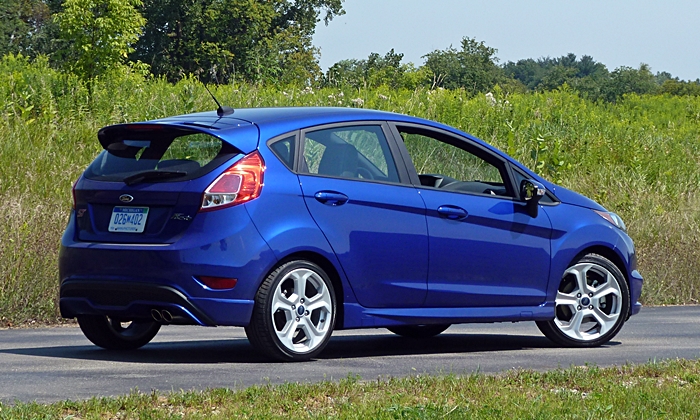
The Fiesta's best angle. A large number of elements come together perfectly around the tail lamps.

Worst implementation of MFT yet. Small, crowded, distant touch screen.
| Price or payments |
 Better
Worse
Better
Worse
|
A base Fiesta ST lists for $22,195. Add $1,995 for heated Recaro seats with cloth centers and leather bolsters. You can also add $795 each for nav and a sunroof, and $595 for either of two ST-uniqe paint colors (green and "molten" orange), but we'll ignore these options here.
Oddly, the $24,910 Focus ST comes with fewer standard features than the Fiesta. No SYNC with MyFord Touch, no Sony audio system, no automatic climate control. Add the $2,385 ST2 Package to get these--plus Recaro seats similar to those optional in the Fiesta, and the larger car costs $3,105 more, $27,295 vs. $24,190. But the Fiesta still includes some additional features, most notably heated seats and multi-color interior ambient lighting.
You can get these things in the Focus's ST3 package, but this package also includes some big-buck features not offered in the Fiesta (xenon headlamps, full-leather upholstery), plus nav. So, like anyone seeking to keep the price well under $30,000, we're doing without heated seats in the Focus. Adjust for the remaining feature differences and the Focus ST is about $3,500 more, a meaningful amount and easily the #1 reason to get the Fiesta ST instead. (Unless you happen to have a very small garage and the larger car won't fit. This isn't hypothetical--one TrueDelta member has ruled out the Focus ST for this reason.)
The MINIs are in another price segment. Take your pick, three-door Cooper Clubman S or four-door Cooper Countryman S, either (at 2013 prices) is about $7,700 more than the 2014 Fiesta ST after a small feature-based adjustment in the Ford's favor.
The Honda Civic Si is the size of the Focus, not the Fiesta. Add a sunroof to the Fiesta ST because one is standard on the Honda, plus the Recaros, and the Ford lists for $1,480 more than the 2013 Honda. But the Si is feature-deficient. You'll actually have to take the key out of your pocket and stick it into the ignition, and the seats include no animal hides. A nearly $2,600 feature-based adjustment more than compensates for the Fiesta ST's higher price.
Now we head into the thick of things. A 2013 Veloster Turbo lists for $1,295 less than a Recaro'd Fiesta--until you add floor mats ($110) and sticky tires ($1,200). Then they're within $15. Adjusting for remaining feature differences gives the Fiesta about an over $500 advantage.
The story is much the same with the 2013 JUKE NISMO. Before the feature-based adjustment the Nissan lists for $195 less, afterwards it's about $1,300 more.
Bottom line: even with the pricey Recaros the Fiesta undercuts all competitors, at least once features are adjusted for. If you can (or must) do without the Recaros, the list price would be $1,995 lower and the feature-adjusted differences another $800 in the Ford's favor. There's a lot of bang for the buck here.
| Exterior styling |
 Better
Worse
Better
Worse
|
I liked the look of the original ovoid Focus hatchback, and the Fiesta hatchback takes the same theme a step or two further. There's a lot going on, but it all comes together perfectly, with nothing appearing extraneous or out of proportion. Took a close look at how all of the lines come together around the high-mounted tail lamps.
To this shape the ST adds a larger grille much like that on the Focus ST (some people see a bit too much grouper here), side skirts, a rear diffuser, and larger wheels. Some people might find the look overly boy-racer, but for me the overall appearance successfully finds a good balance between sportiness and tastefulness. German manufacturers have been adding much more tastefully questionable bits to much more expensive cars, and no one seems to find them overly adolescent there.
This said, a Veloster will grab more attention, while a MINI has a retro charm all its own. Whether either is more attractive than the Fiesta is a matter of personal taste, they're all excellent designs in their own ways.
And the JUKE? Much more than the others it's an acquired taste, especially with the red NISMO bits. It will attract more attention than the Fiesta ST, but not always for desirable reasons.
| Quietness |
 Better
Worse
Better
Worse
|
Since the Fiesta ST's high level of refinement costs it quite a few "fun to drive" points, it seems only fair to include this refinement as a reason some people might buy the car instead of something else. Noise from all sources is considerably lower than in the typical car this size. The symposer shuts up while cruising, so there's no engine drone. You'll often think you're going 20 miles-per-hour slower than you actually are.
The Fiesta's ST ride is very firm, but far from harsh. Bumps and divots in the road are summarily dispatched. You'll feel them, but very briefly, and you won't much hear them. A rock-solid body structure successfully resists tremors. Though a small, high-performance car, the Fiesta ST would not prove tiresome on long highway drives.
This pro only applies in comparisons to the MINIs, JUKE, and Veloster. The Focus ST has the same strength/weakness.
| |
Compared to the JUKE |
| Front seat support & comfort |
 Better
Worse
Better
Worse
|
I personally find the Fiesta's optional Recaro seats comfortable as well as solidly supportive in hard turns. But I'm fairly slender. If you're any wider than I am, you'll likely find the firm, tightly-spaced bolsters uncomfortable, possibly to such an extent that you wouldn't buy the car with them. Even if you are slender, if the amount of lumbar support isn't to your liking, well, it's not adjustable.
The base Fiesta ST has the same seats as the regular Fiesta, complete with a manual lumbar adjuster, just in different upholstery. If these were similar to the seats in the non-ST Focus, I'd readily recommend saving $1,995. But the Fiesta's standard buckets don't provide as much lateral support as those in the Focus, and aren't suitable for a car with such high handling limits. Ford should consider making the standard Focus seats the standard seats in the Fiesta ST.
(All of the Fiesta STs at the event had the Recaros. I'm basing my evaluation of the base seats on Ford's statement that they are the same as those in the regular Fiesta.)
NISMO's best mod to the Juke is a set of buckets that look great and feel even better. Though very supportive in hard turns, a wider range of people will find them comfortable.
| Rear seat room & comfort |
 Better
Worse
Better
Worse
|
The Fiesta's rear seat is about as tight as you'll find in a four-door vehicle. Add the Recaros, and there's even less space back there. At 5-9 I can barely manage to sit behind myself. The seat itself is fairly comfortable, there's just no room to spare. Even the MINI Countryman and JUKE provide a little more space. Need a couple more inches? Step up to the Focus ST.
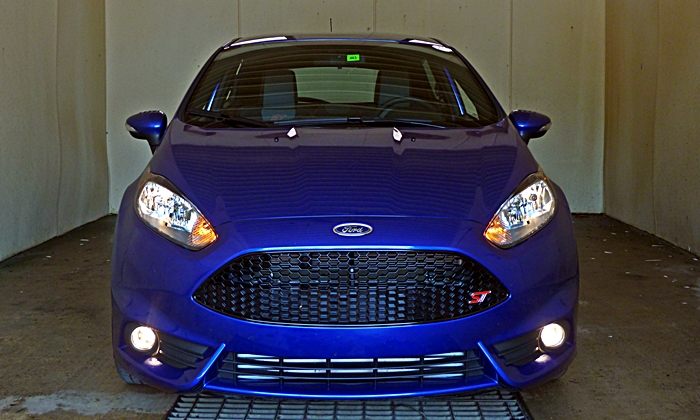
Same yowling grille as the Focus ST. So do you see a grouper or a Pokemon?
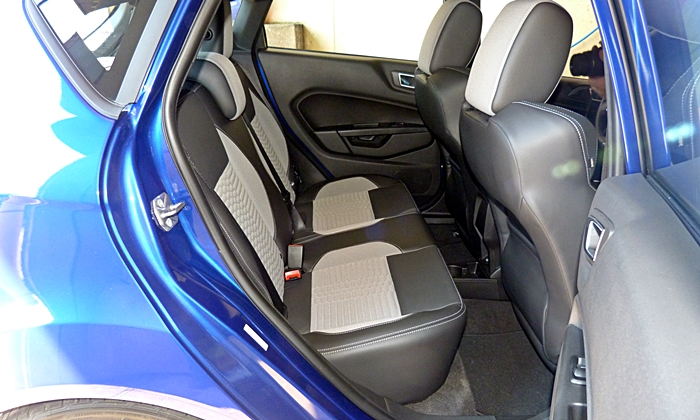
Even tighter back here than in a JUKE (and that's saying something). Huge Recaros don't help.
| Controls and instruments |
 Better
Worse
Better
Worse
|
The Fiesta ST has the much-criticized MyFord Touch infotainment interface as standard equipment. The Fiesta could be the system's worst implementation yet. Nearly all functions must be handled via voice commands or the touch screen. Said touch screen is smaller than in other Fords, 6.5-inchs instead of 8.0. So the already too small and too closely spaced virtual controls are even smaller and more tightly packed here. But wait, there's more: the smaller screen is also too far away to reach without leaning forward out of the seat. To top it all off, the screen is recessed, so some often used "buttons" on its lower edge are especially hard to tap. In the Fusion, Ford located the screen much closer to the driver, and did not recess it. They ought to do the same in their other models.
The JUKE has some less than intuitive controls, especially for its trip computer/performance monitor/light show, but nothing that compares to MFT in the Focus. Want to surf the radio? There's an easily-reached knob for that (as there should be in every car).
| Audio & nav systems |
 Better
Worse
Better
Worse
|
The Fiesta ST has a standard Sony audio system. The Focus ST has an optional Sony audio system. But while the latter has 355 watts and a subwoofer, the former has only 100 watts and no sub. While watt ratings must be taken with a few grains of salt, they should be comparable in this case, and even my inexpert ears can tell a big difference between the two. The Fiesta's system isn't as clear or as powerful. Turn the volume up and it sounds muddy. One wonders why Sony agreed to provide a system so much less capable than those in other Ford models.
| Cargo capacity |
 Better
Worse
Better
Worse
|
The Fiesta has enough cargo space for just about anyone's typical around-town needs. The rear seat can be folded--but not nearly flat. There's quite a bit of extra space beneath the cargo floor, but anything stowed there will rest on the full-size spare tire. Unlike other manufacturers, Ford doesn't include a below-floor cargo tray to make the space useful.
The JUKE offers less cargo space behind its second row (8.9 vs. 14.9 cubic feet), but more with the seat folded (29.3 vs. 25.4). The Focus ST, though hardly outstanding in this regard, can stow considerably more stuff than either (23.8 cubes with the seat up, 44.8 with it folded). If you have a family and will be taking trips in the car, the Focus is much more viable (though even then everyone best pack light).
| |
Compared to the JUKE |
| Fuel economy |
 Better
Worse
Better
Worse
|
If I had six or seven "why to buys" to work with, fuel economy would be among them. The Fiesta ST is rated 26 mpg city, 35 mpg highway. The heavier, more powerful Focus ST comes in three lower on each. The Veloster Turbo? 24/35 following Hyundai's semi-voluntary downward revision. The JUKE, with its taller body, iffier aerodynamics, and shorter gearing has a decent city rating, 25, but a lower one on the highway, 31.
As tends to be the case with performance-oriented engines, premium fuel is recommended in the Fiesta ST, but not required (power will be reduced with regular).
| Interior styling |
 Better
Worse
Better
Worse
|
The interior of the Fiesta ST has just a few mildly odd details. Overall its reasonably attractive, with materials a cut above the small car average.
One thing missed from the Focus ST: in the Fiesta ST only red inserts are offered in the seats. In the larger car blue and tangerine inserts are offered (but red ones aren't). So in a blue car like the one tested you get...gray. Some people find the colorful inserts a bit much. But, to my eye, the interior is a bit blah without them.
If you want the colorful seat inserts, and aren't flexible on the exterior color, your choice between the Fiesta ST and the Focus ST might be made for you.
Anyone considering a car in this group should check insurance rates before buying. They could vary considerably. If the Fiesta ST ends up much less expensive to insure than the more powerful Focus ST, my preference between the two could shift.
Ideally, the Fiesta ST's technical excellence and the JUKE NISMO's rowdy personality would be available in the same vehicle. But, partly owing to inescapable trade-offs, they're not. Granted, some people (such as those who've found the Focus ST insufficiently refined compared to the VW GTI) will prefer the Fiesta ST just as it is.
As much as I enjoy driving the JUKE, its styling and personality might be overly extreme for all but Mountain Dew junkies. Like the Vegas Strip, the NISMO is a great place to visit from time to time, but I'm not sure I'd want to live there. And the Nissan's handling capabilities simply don't compare to the Fiesta's.
When all is said and done, the Fiesta's toughest competitor can be found within the same showroom. The Focus ST feels stronger and more responsive. It's the more involving car. The hoped-for payoff of the Fiesta's smaller size and lower curb weight didn't happen. (Was Ford responding to those comparison test verdicts in favor of the VW?)
If the Focus ST didn't exist, then I'd be sending you to the Ford dealer to buy a Fiesta ST. As it is, another $3,100 gets you a car with more power, more room, and more engaging responses. Not a small amount, but close enough that this alternative cannot be ignored.
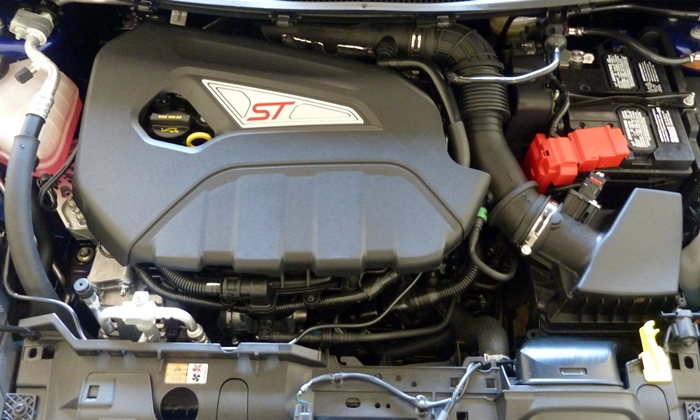
Yes, another boring cover. To see what's beneath it, check the full gallery.
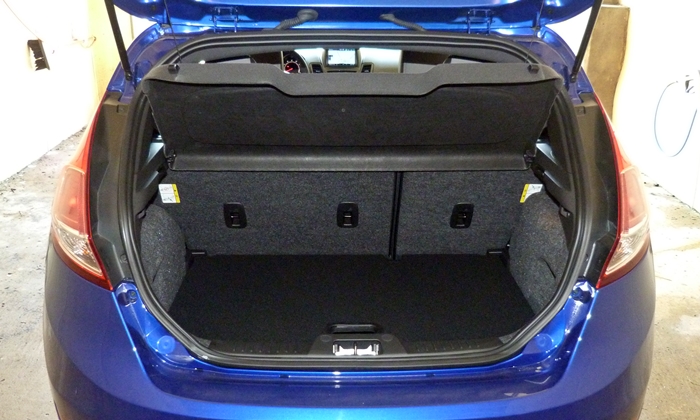
Enough cargo space for typical around-town needs, but not much else.
See more 2014 Ford Fiesta photos
Ford and Nissan each provided cars at media events. Ford also provided a lunch. MINI of Ann Arbor (866-707-1733) provided a Cooper Countryman S test drive. Dorothy Howard at Varsity Ford in Ann Arbor (734-332-1782) provided a Focus ST test drive.


